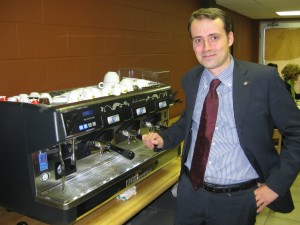Recently I took part in a coffee tasters workshop that was held in Vancouver, Canada, this hands on workshop was taught by Carlo Odello who works for the International Institute of Coffee Tasters in Brescia, Italy. The workshop came about off an invitation by Caffè Umbria a coffee roasting company based in Seattle, which for years had been working only with the Italian standard. With the help of Pasquale Madeddu, Emanuele Bizzarri and Jesse Sweeney of Caffe Umbria the first two Espresso Italiano Tasting courses were born. For the first time Carlo came to Vancouver, Canada and to Portland, OR, USA to teach the courses in collaboration with Caffe Umbria.
Carlo Odello is a trainer, board member and the Director of Communication for the International Institute of Coffee Tasters (IIAC). Mr. Odello is also the Communications Manager for the Italian Espresso National Institute and a board member of the Taster Study Center, the most advanced Italian company in sensory analysis. The IIAC is a non-profit association, founded with the intent of developing and implementing a scientific method to give a measurable value to the sensory value of coffee.
Making a perfect espresso is not a simple task. A large number of variables have to be kept under control: the coffee blend, the coffee grinder, the espresso machine and the barista’s hand of course. Every single variable will influence the final result and the judgment on the quality of the espresso in the cup is up to the taster. In this course one of the goals is to distinguish good espresso from poor one and how to get a precise sensory profile of the cup in front of you.
ECM in Vancouver was the host location for the workshop, the participants range from baristas from local cafes to owners of cafes to a manager in a winery restaurant from the Okanagan region of British Columbia. All of the participants were educated on taste including sensory data, basically the science of tasting coffee. The coffees used were from a roaster in Florence, Italy and the beans were shipped two months earlier from the roaster to Vancouver to ensure the coffees would arrive in time for use in the workshop. We tasted four coffees in the first round of tasting in the morning which outlined the visual sensations, oflactive sensations, gustative/tactile sensations and sensations perceived at the back of the throat. In the afternoon we tasted three coffees in the second round.
We also learned about roasting, the art of blending, packaging, the coffee grinder, the doser, cleaning the hopper, extraction, the Italian standards, the result in the cup, and the espresso machine.
Written By: Richard Wolak


